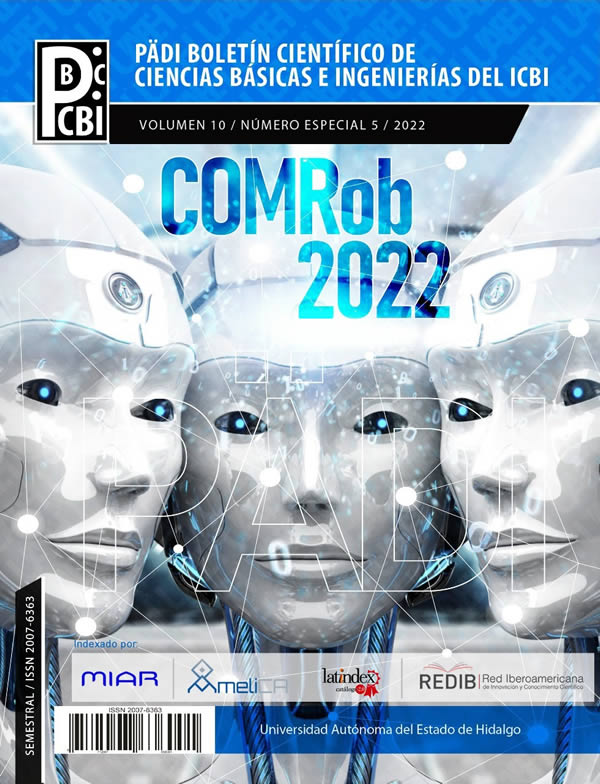Sliding PID control with base time generator for a magnetic levitation system
Abstract
Slidings PID controllers have been designed for application in tracking tasks in robotic systems. Subsequently, the application of the terminal attractors theory was used to strengthen this type of controllers. In this article, the experimental results of the use of a sliding PID with time base generator to regulate the position of a magnetic levitation system are presented.
Downloads
References
A. E. Fitzgerald, C. K. and Umas, D. (2004). Maquinas El´ectricas, 1a ed. México: Mc Graw Hill.
Al-Muthairi, F. and Zribi, M. (2004). Sliding mode control of a magnetic levitation system. Mathematical Problems in Engineering.
C. Muresan, C. Ionescu, S. F. and Keyser, R. (2001). Fractional order control of unstable processes: the magnetic levitation study case. Nonlinear Dynamics, vol. 80.
C. Yang, F. Y. and Dan, P. (2020). Adaptive sliding mode pid control for underwater manipulator based on legendre polynomial function approximation and its experimental evaluation. Applied Sciences, vol. 10:pp. 1728.
Charara, A. (1996). Nonlinear control of a magnetic levitation system without premagnetization. IEEE Transactions on Control Systems Technology, vol. 4, no. 5:pp. 513–523.
Gregory, R. D. (2006). Classical mechanics an undergraduate text, ,1a ed., K: Cambridge University Press.
Hajjaji, A. E. and Ouladsine, M. (2001). Modeling and nonlinear control of magnetic levitation systems. IEEE Transactions on Industrial Electronics, vol. 48:pp. 831–838.
J. Ollervides, V. Santibanez, M. L. and Dzul, A. (2010). Aplicación de control borroso a un sistema de suspension magnética: Comparación experimental. RIAIM, vol. 1.
M. Wenk, J. Kluhspies, e. a. (2018). Maglev: Science Experiment or the Future of Transport Practical Investigation of Future Perspectives and Limitations of Maglev Technologies in Comparison with Steel-Wheel-Rail. O. A. Domínguez-Ramírez, A. Jarillo-Silva, V. P.-V. and Sepulveda-Cervantes, G. (2011). Neurorehabilitacion robótica basada en guiado kinestésico local para miembro superior con movimiento involuntario. Ciencia Universitaria, vol. 2.
O. A. Domínguez-Ramírez, A. Jarillo-Silva, V. P.-V. F. R.-S. and Cervantes, G. (2011). Neurorehabilitacion robótica basada en guiado kinestésico local para miembro superior con movimiento involuntario. Ciencia Universitaria, no. 2:pp. 19 – 33.
P. Morasso, V. S. and Spada, G. (1997). A computational theory of targeting movements based on force fields and topology representing networks. Neurocomputing Elsevier, vol. 15. Parra-Vega, V. (2001). Second order sliding mode control for robot arms with time base generators for finite-time tracking. Dynamics and Control, vol.11:pp. 175–186.
Parra-Vega, V. and Arimoto, S. (1995). Adaptive control for robot manipulators with sliding mode error coordinate system: free and constrained motions. IEEE International Conference on Robotics and Automation, vol. 1:pp. 591–596.
Parra-Vega, V. and Arimoto, S. (2001). Nonlinear pid control with sliding modes for tkacking of robot manipulators. IEEE International Conference on Control Applications.
Poznyak, A. S. (2005). Modelado matem´atico de los Sistemas Mecánicos, Eléctricos y Electromecánicos, 1a ed., México: CINVESTAV.
Quanser (2019). Magnetic levitation [online]. https://www.quanser.com/products/magnetic-levitation.
R. Raygosa, E. Olgu´ın-D´ıaz, V. P.-V. and Munoz, A. (2015). Control libre de modelo basado en modos deslizantes integrales para robots submarinos. RIAI, vol. 11:pp. 313–324.
Slotine, J. J. E. and Li, W. (1987). On the adaptive control of manipulators. Internat J. Robotics Research, vol. 3:pp. 49–59.
V. Parra-Vega, L. Garc´ıa-Valdovinos, A. C.-T. and Dom´ınguez-Ram´ırez, O. A. (2003). Sliding pid control for tracking in finite time for robot arms. International Conference on Advanced Robotics, vol. 11.
V. Parra-Vega, S. Arimoto, Y. L. G. H. and Akella, P. (2004). Dynamic sliding pid control for tracking of robot manipulators: Theory and experiments. Robotics and Automation, IEEE Transactions, vol. 19:pp. 967 – 976.
Victorino, J. (2021). Estímulo háptico basado en fuerza magn´etica de un sistela de levitación. Tesis de maestría, Departamento de computación y electrónica, UAEH, Mineral de la reforma, Hgo, México.
Wong, T. H. (1986). Design of a magnetic levitation control system undergraduate project. IEEE Tansactions On Education, vol. E29, no. 4:pp. 196–200













